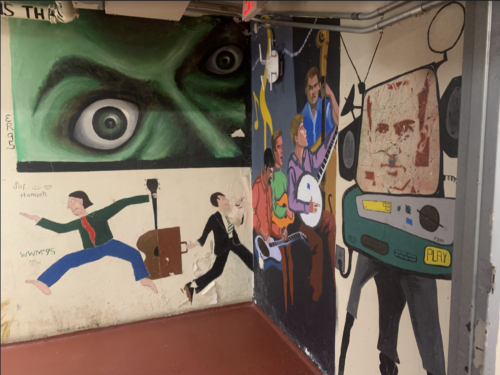In 1988, members of the Adams House Committee joined House Master Robert Kiely in formulating a plan to paint the tunnels of the House basement. Back when Harvard’s Houses were largely organized by “personality,” Adams thrived with artists. One weekend in January, while the superintendent was away and without the Dean’s approval, artists living in the House snuck downstairs and painted for hours. Working deep into the night, they all followed one rule: paint a representation of yourself, something that speaks directly to you. Although most of the work from that original weekend has now been painted over, the rule is still followed by contributors today.
This historic capsule of art and prose provides a window into students’ self-awareness and worldviews across the years. A 1992 graphic by someone with the initials LMR memorializes a pool that had existed in Adams for generations. Before it was converted into a theatre, the pool was known as a place where LGBTQ+ residents could freely express themselves, most famously at boisterous “clothing-optional” parties. “It’s all true,” LMR wrote. “They all swam naked in the pool.”

Many other illustrations in the basement reveal the spirit and activities of Adams. Written along some pipes are the words: “All that is necessary for the triumph of evil is for good men to live in ADAMS.” One might interpret these lyrics as suggesting that the House is so soul-crushing, that for evil to take over the world, all good people must live in it. Elusive, this line sparks onlookers’ curiosity about the distasteful or rebellious history of Adams—perhaps that is the objective of all the drawings in the basement.

Inspiration also abounds on these walls. Some creators have posted words that have real-world significance: “Let us not look back in Anger or forward in Fear, but around us Awareness,” James Thurber wrote in 2005. “In every life there comes a time when that dream you dream becomes that thing you do,” Grace Sun wrote in 2013.

While these tunnels would stir the interests of historians and psychologists, they also exhibit a variety of random curiosities whose intended meaning is unknown. One feels as if they are walking through an abandoned elementary school as they pass murals of Snoopy and Charlie Brown and snapshots of Winnie the Pooh and Piglet. Excerpts from nursery rhymes like Hey Diddle Diddle, Russian scripture, and a plethora of obscure paintings cover every inch of the walls.
For over three decades, Harvard students have used the Adams House basement to demonstrate their understanding of the world and immortalize messages for future generations. The underground tunnels are continually repainted to make room for future artwork, suggesting that their purpose and popularity have not diminished over time. Crowded as they may be, the walls provide a clean slate for students’ imaginations and a platform to represent themselves and their ideas, just as Kiely and the House Committee of 1988 had imagined.

Matthew Doctoroff ’25 (matthewdoctoroff@college.harvard.edu) does not want to be placed in Adams House.

